

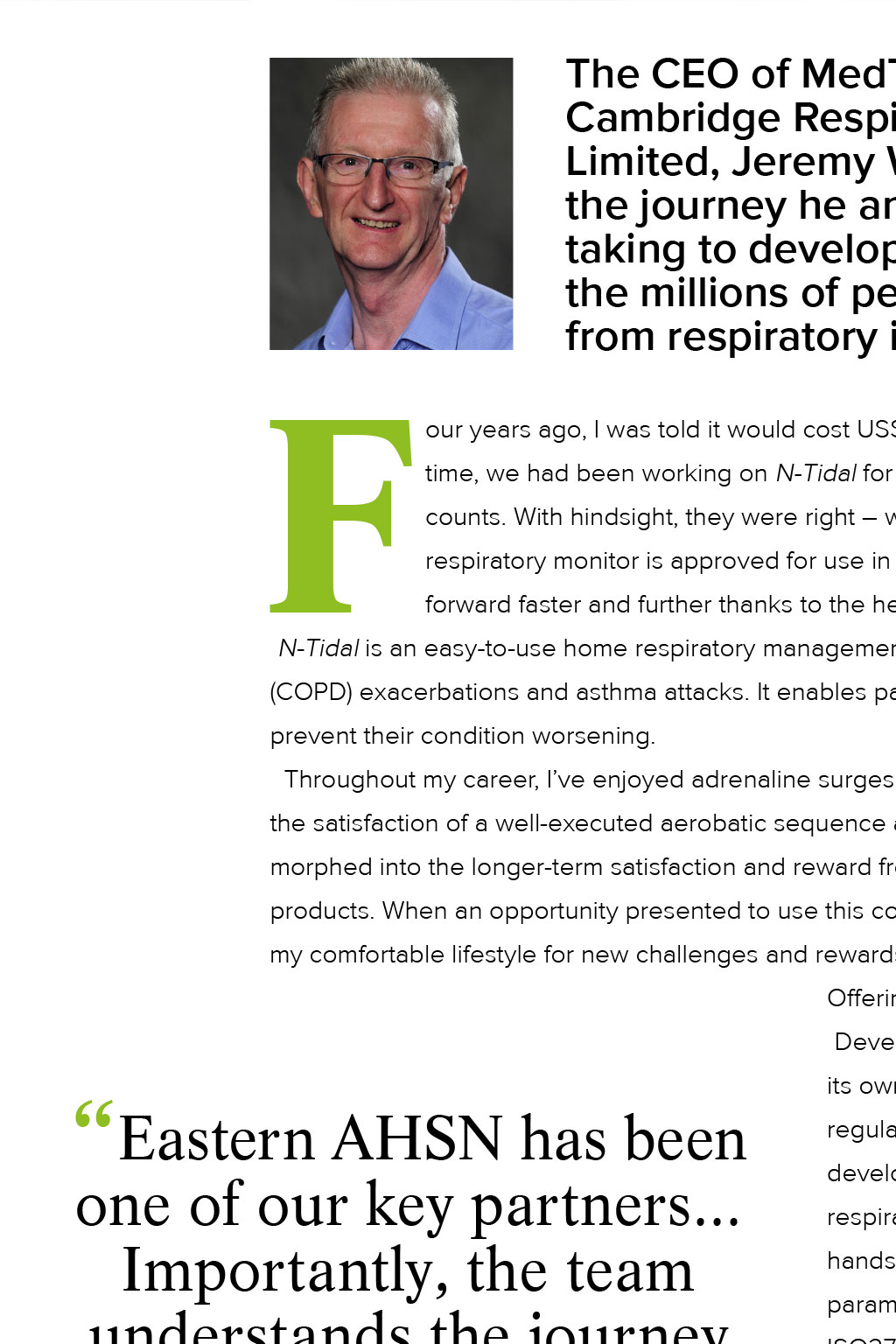
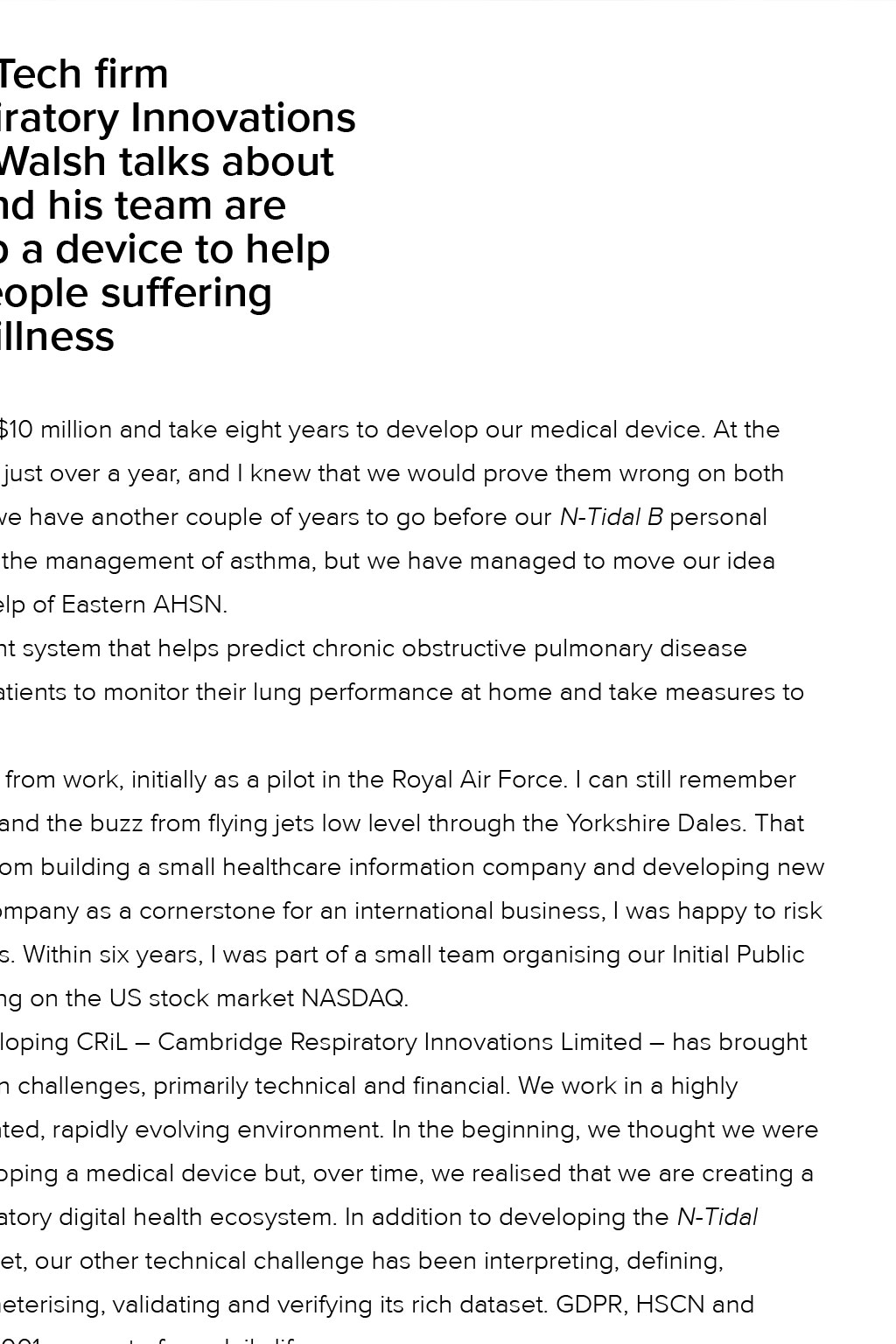
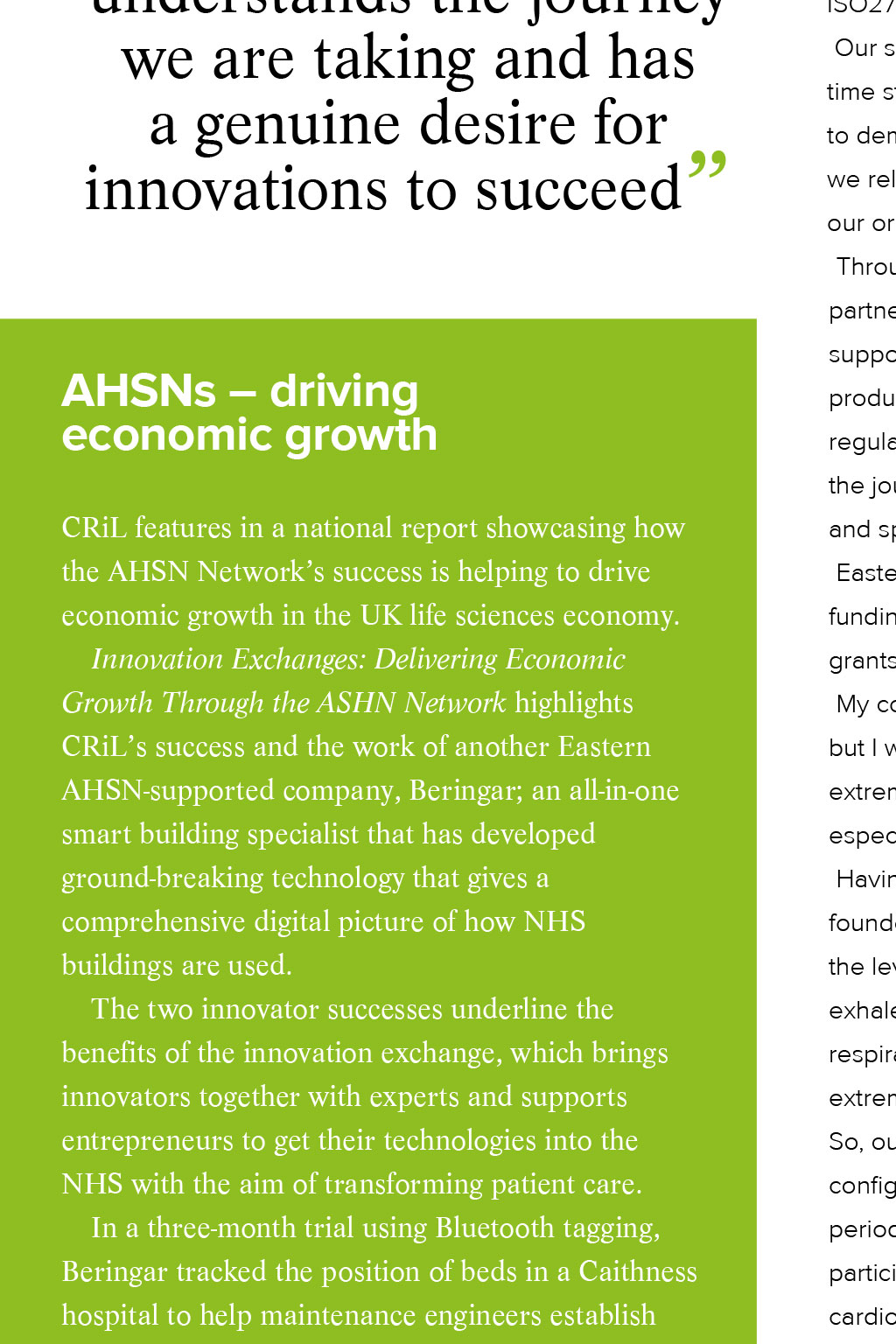
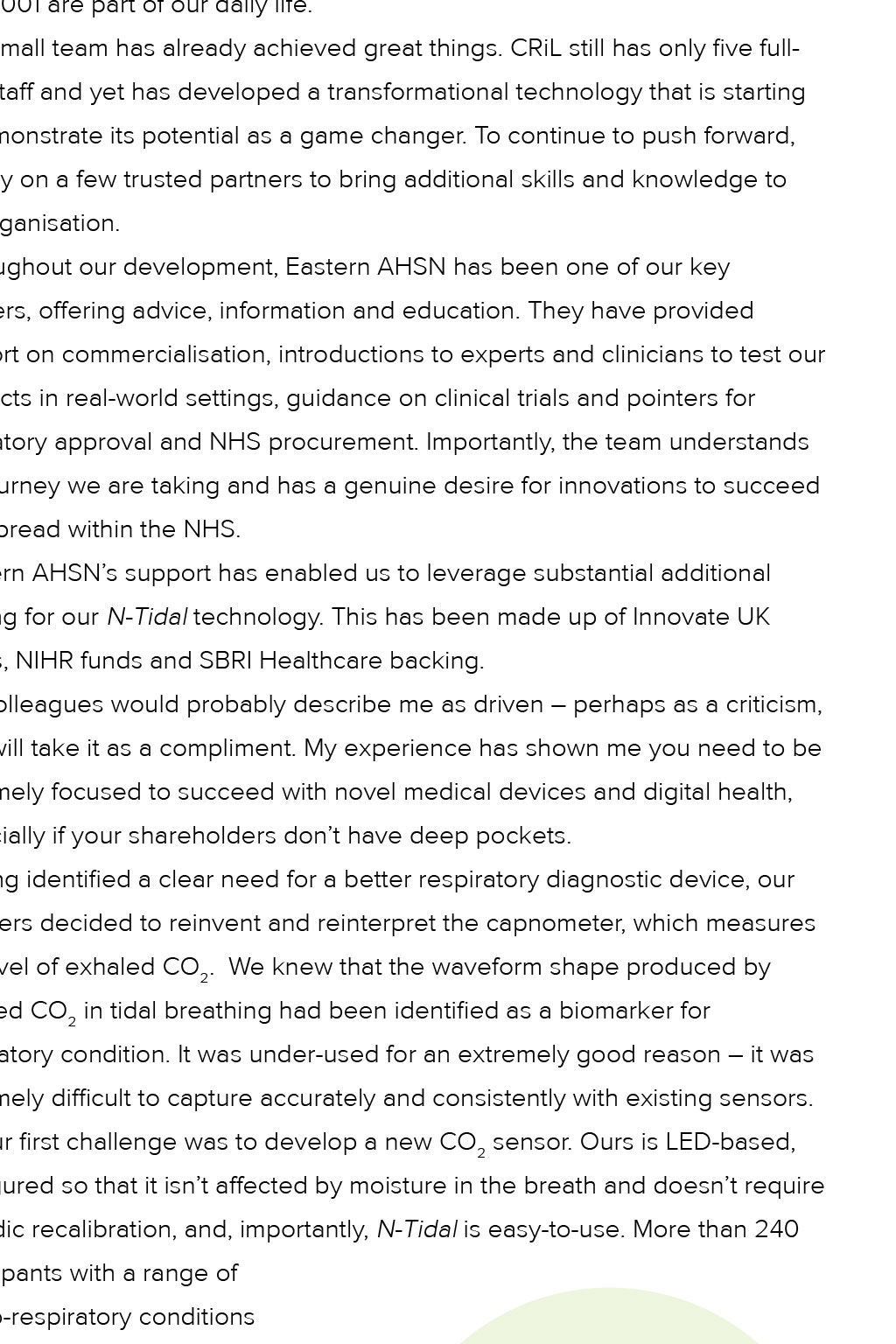
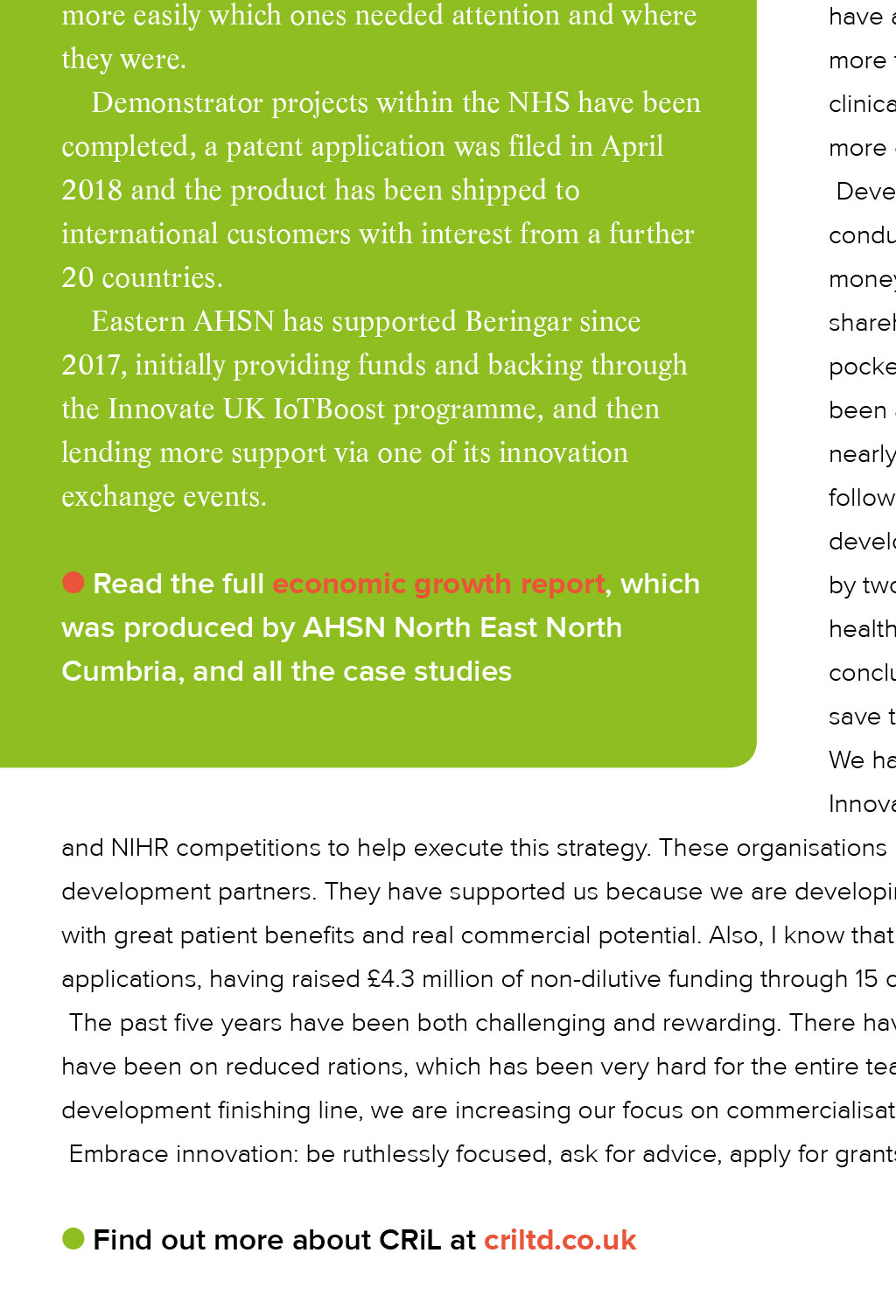
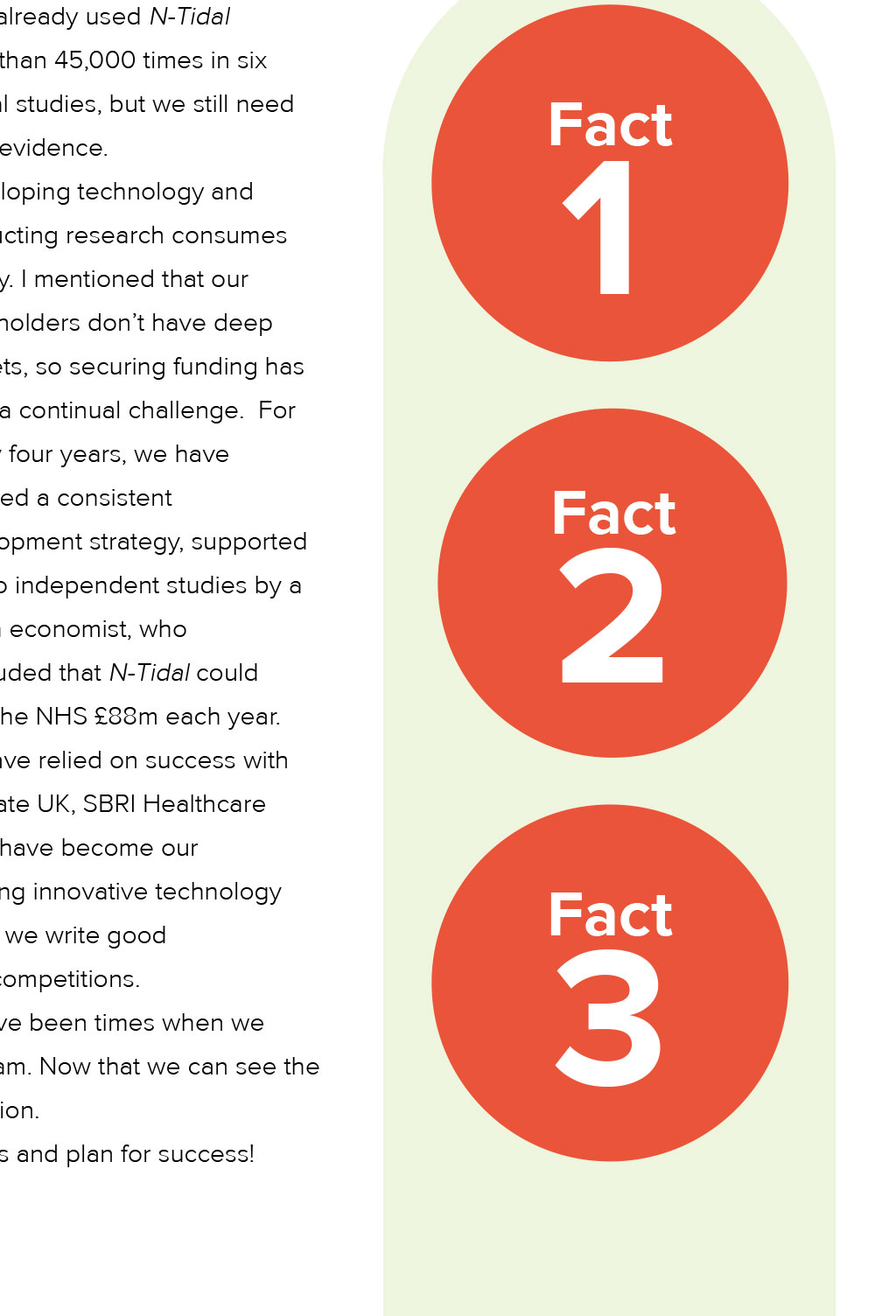









Innovator profile: CRiL Breathe easy The CEO of MedTech firm Cambridge Respiratory Innovations Limited, Jeremy Walsh talks about the journey he and his team are taking to develop a device to help the millions of people suffering F from respiratory illness our years ago, I was told it would cost US$10 million and take eight years to develop our medical device. At the time, we had been working on N-Tidal for just over a year, and I knew that we would prove them wrong on both counts. With hindsight, they were right – we have another couple of years to go before our N-Tidal B personal respiratory monitor is approved for use in the management of asthma, but we have managed to move our idea forward faster and further thanks to the help of Eastern AHSN. N-Tidal is an easy-to-use home respiratory management system that helps predict chronic obstructive pulmonary disease (COPD) exacerbations and asthma attacks. It enables patients to monitor their lung performance at home and take measures to prevent their condition worsening. Throughout my career, I’ve enjoyed adrenaline surges from work, initially as a pilot in the Royal Air Force. I can still remember the satisfaction of a well-executed aerobatic sequence and the buzz from flying jets low level through the Yorkshire Dales. That morphed into the longer-term satisfaction and reward from building a small healthcare information company and developing new products. When an opportunity presented to use this company as a cornerstone for an international business, I was happy to risk my comfortable lifestyle for new challenges and rewards. Within six years, I was part of a small team organising our Initial Public ‘Eastern AHSN has been one of our key partners... Importantly, the team understands the journey we are taking and has a genuine desire for ’ innovations to succeed Offering on the US stock market NASDAQ. Developing CRiL – Cambridge Respiratory Innovations Limited – has brought its own challenges, primarily technical and financial. We work in a highly regulated, rapidly evolving environment. In the beginning, we thought we were developing a medical device but, over time, we realised that we are creating a respiratory digital health ecosystem. In addition to developing the N-Tidal handset, our other technical challenge has been interpreting, defining, parameterising, validating and verifying its rich dataset. GDPR, HSCN and ISO27001 are part of our daily life. Our small team has already achieved great things. CRiL still has only five full- time staff and yet has developed a transformational technology that is starting to demonstrate its potential as a game changer. To continue to push forward, we rely on a few trusted partners to bring additional skills and knowledge to our organisation. Throughout our development, Eastern AHSN has been one of our key partners, offering advice, information and education. They have provided support on commercialisation, introductions to experts and clinicians to test our products in real-world settings, guidance on clinical trials and pointers for regulatory approval and NHS procurement. Importantly, the team understands the journey we are taking and has a genuine desire for innovations to succeed and spread within the NHS. Eastern AHSN’s support has enabled us to leverage substantial additional funding for our N-Tidal technology. This has been made up of Innovate UK grants, NIHR funds and SBRI Healthcare backing. My colleagues would probably describe me as driven – perhaps as a criticism, but I will take it as a compliment. My experience has shown me you need to be extremely focused to succeed with novel medical devices and digital health, especially if your shareholders don’t have deep pockets. Having identified a clear need for a better respiratory diagnostic device, our founders decided to reinvent and reinterpret the capnometer, which measures the level of exhaled CO2. We knew that the waveform shape produced by exhaled CO2 in tidal breathing had been identified as a biomarker for respiratory condition. It was under-used for an extremely good reason – it was extremely difficult to capture accurately and consistently with existing sensors. So, our first challenge was to develop a new CO2 sensor. Ours is LED-based, configured so that it isn’t affected by moisture in the breath and doesn’t require periodic recalibration, and, importantly, N-Tidal is easy-to-use. More than 240 participants with a range of cardio-respiratory conditions have already used N-Tidal more than 45,000 times in six clinical studies, but we still need 1 AHSNs – driving economic growth CRiL features in a national report showcasing how the AHSN Network’s success is helping to drive economic growth in the UK life sciences economy. Innovation Exchanges: Delivering Economic Growth Through the ASHN Network highlights CRiL’s success and the work of another Eastern AHSN-supported company, Beringar; an all-in-one smart building specialist that has developed ground-breaking technology that gives a comprehensive digital picture of how NHS buildings are used. The two innovator successes underline the benefits of the innovation exchange, which brings innovators together with experts and supports entrepreneurs to get their technologies into the NHS with the aim of transforming patient care. In a three-month trial using Bluetooth tagging, Beringar tracked the position of beds in a Caithness hospital to help maintenance engineers establish more easily which ones needed attention and where they were. Demonstrator projects within the NHS have been completed, a patent application was filed in April 2018 and the product has been shipped to international customers with interest from a further 20 countries. Eastern AHSN has supported Beringar since 2017, initially providing funds and backing through the Innovate UK IoTBoost programme, and then lending more support via one of its innovation exchange events. ● Read the full economic growth report, which was produced by AHSN North East North Cumbria, and all the case studies more evidence. Developing technology and conducting research consumes money. I mentioned that our shareholders don’t have deep pockets, so securing funding has been a continual challenge. For nearly four years, we have followed a consistent development strategy, supported by two independent studies by a health economist, who concluded that N-Tidal could save the NHS £88m each year. We have relied on success with Innovate UK, SBRI Healthcare Fact F2act development partners. They have supported us because we are developing innovative technology 3 with great patient benefits and real commercial potential. Also, I know that we write good applications, having raised £4.3 million of non-dilutive funding through 15 competitions. The past five years have been both challenging and rewarding. There have been times when we have been on reduced rations, which has been very hard for the entire team. Now that we can see the development finishing line, we are increasing our focus on commercialisation. and NIHR competitions to help execute this strategy. These organisations have become our Embrace innovation: be ruthlessly focused, ask for advice, apply for grants and plan for success! Fact Breathe easy Innovator profile: CRiL The CEO of MedTech firm Cambridge Respiratory Innovations Limited, Jeremy Walsh talks about the journey he and his team are taking to develop a device to help the millions of people suffering F from respiratory illness our years ago, I was told it would cost US$10 million and take eight years to develop our medical device. At the time, we had been working on N-Tidal for just over a year, and I knew that we would prove them wrong on both counts. With hindsight, they were right – we have another couple of years to go before our N-Tidal B personal respiratory monitor is approved for use in the management of asthma, but we have managed to move our idea forward faster and further thanks to the help of Eastern AHSN. N-Tidal is an easy-to-use home respiratory management system that helps predict chronic obstructive pulmonary disease (COPD) exacerbations and asthma attacks. It enables patients to monitor their lung performance at home and take measures to prevent their condition worsening. Throughout my career, I’ve enjoyed adrenaline surges from work, initially as a pilot in the Royal Air Force. I can still remember the satisfaction of a well-executed aerobatic sequence and the buzz from flying jets low level through the Yorkshire Dales. That morphed into the longer-term satisfaction and reward from building a small healthcare information company and developing new products. When an opportunity presented to use this company as a cornerstone for an international business, I was happy to risk my comfortable lifestyle for new challenges and rewards. Within six years, I was part of a small team organising our Initial Public ‘Eastern AHSN has been one of our key partners... Importantly, the team understands the journey we are taking and has a genuine desire for ’ innovations to succeed AHSNs – driving economic growth CRiL features in a national report showcasing how the AHSN Network’s success is helping to drive economic growth in the UK life sciences economy. Innovation Exchanges: Delivering Economic Growth Through the ASHN Network highlights CRiL’s success and the work of another Eastern AHSN-supported company, Beringar; an all-in-one smart building specialist that has developed ground-breaking technology that gives a comprehensive digital picture of how NHS buildings are used. The two innovator successes underline the benefits of the innovation exchange, which brings innovators together with experts and supports entrepreneurs to get their technologies into the NHS with the aim of transforming patient care. In a three-month trial using Bluetooth tagging, Beringar tracked the position of beds in a Caithness hospital to help maintenance engineers establish more easily which ones needed attention and where they were. Demonstrator projects within the NHS have been completed, a patent application was filed in April 2018 and the product has been shipped to international customers with interest from a further 20 countries. Eastern AHSN has supported Beringar since 2017, initially providing funds and backing through the Innovate UK IoTBoost programme, and then lending more support via one of its innovation exchange events. ● Read the full economic growth report, which was produced by AHSN North East North Cumbria, and all the case studies and NIHR competitions to help execute this strategy. These organisations have become our development partners. They have supported us because we are developing innovative technology with great patient benefits and real commercial potential. Also, I know that we write good applications, having raised £4.3 million of non-dilutive funding through 15 competitions. The past five years have been both challenging and rewarding. There have been times when we have been on reduced rations, which has been very hard for the entire team. Now that we can see the development finishing line, we are increasing our focus on commercialisation. Offering on the US stock market NASDAQ. Developing CRiL – Cambridge Respiratory Innovations Limited – has brought its own challenges, primarily technical and financial. We work in a highly regulated, rapidly evolving environment. In the beginning, we thought we were developing a medical device but, over time, we realised that we are creating a respiratory digital health ecosystem. In addition to developing the N-Tidal handset, our other technical challenge has been interpreting, defining, parameterising, validating and verifying its rich dataset. GDPR, HSCN and ISO27001 are part of our daily life. Our small team has already achieved great things. CRiL still has only five full- time staff and yet has developed a transformational technology that is starting to demonstrate its potential as a game changer. To continue to push forward, we rely on a few trusted partners to bring additional skills and knowledge to our organisation. Throughout our development, Eastern AHSN has been one of our key partners, offering advice, information and education. They have provided support on commercialisation, introductions to experts and clinicians to test our products in real-world settings, guidance on clinical trials and pointers for regulatory approval and NHS procurement. Importantly, the team understands the journey we are taking and has a genuine desire for innovations to succeed and spread within the NHS. Eastern AHSN’s support has enabled us to leverage substantial additional funding for our N-Tidal technology. This has been made up of Innovate UK grants, NIHR funds and SBRI Healthcare backing. My colleagues would probably describe me as driven – perhaps as a criticism, but I will take it as a compliment. My experience has shown me you need to be extremely focused to succeed with novel medical devices and digital health, especially if your shareholders don’t have deep pockets. Having identified a clear need for a better respiratory diagnostic device, our founders decided to reinvent and reinterpret the capnometer, which measures the level of exhaled CO2. We knew that the waveform shape produced by exhaled CO2 in tidal breathing had been identified as a biomarker for respiratory condition. It was under-used for an extremely good reason – it was extremely difficult to capture accurately and consistently with existing sensors. So, our first challenge was to develop a new CO2 sensor. Ours is LED-based, configured so that it isn’t affected by moisture in the breath and doesn’t require periodic recalibration, and, importantly, N-Tidal is easy-to-use. More than 240 participants with a range of Embrace innovation: be ruthlessly focused, ask for advice, apply for grants and plan for success! cardio-respiratory conditions have already used N-Tidal more than 45,000 times in six clinical studies, but we still need more evidence. Developing technology and conducting research consumes money. I mentioned that our shareholders don’t have deep pockets, so securing funding has been a continual challenge. For nearly four years, we have followed a consistent development strategy, supported by two independent studies by a health economist, who concluded that N-Tidal could save the NHS £88m each year. We have relied on success with Innovate UK, SBRI Healthcare F1act F2act F3act 335 million people globally have asthma, of which 5.4 million are in the UK Out of 64 million people with Chronic Obstructive Pulmonary Disease (COPD) 800,000 are in the UK 20 million people have congestive heart failure – 900,000 are in the UK